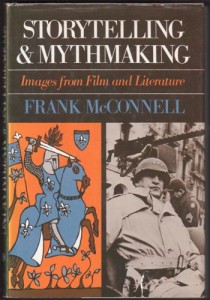This intemperate outburst — possibly written at some point during my stint at the University of California, Santa Barbara in the mid-80s, but far more likely written closer to the book’s publication date (1979), perhaps when I was still living in San Diego — was wisely and tactfully rejected by Chick (Ernest) Callenbach when I submitted it to Film Quarterly. (He added, as I recall, by way of explanation, that Film Quarterly tended to be a “friendly” publication.) Had I written it while I was at Santa Barbara, it would have probably been motivated in part by the fact that the late Frank McConnell (1942-1999) was far and away the most popular English professor at the university. But I’m pretty sure that my objections to his book were textual and ideological rather than personal — even if I later grumpily reflected that his popularity at UCSB was partly predicated on his uncanny capacity to both validate and extravagantly flatter not only whatever was most popular at the time, but also (it seemed) whatever his students said during his lectures, no matter how ill-informed or inane.
I’m reproducing this previously unpublished short review now not because I think it’s fair or reasonable but because I think it still has a valid point to make –- which is also why I kept my draft. — J.R.
STORYTELLING AND MYTHMAKING: IMAGES FROM FILM AND LITERATURE By Frank McConnell. New York: Oxford University Press, $13.95.
It is curious to encounter, on page 199 of Frank McConnell’s intermittently interesting, energetic, occasionally ingenious, and infuriating Storytelling and Mythmaking — which one is tempted to call S & M for short — a reference to “afternoon television” (watched by the hero of Taxi Driver) as “that most unredeemed of American junk meals for the mind.” After devoting a fair amount of his work to glorifying such junk meals as Star Wars (“the most successful film in the history of the art”), Metropolis (“the most permanently durable of science fiction anti-utopias”), The Godfather, Part One (whose baptism scene is “one of the most overwhelming bravura sequences in American film”) and Taxi Driver (which, we’re told, “achieves the same shattering, violent transition from one narrative world to the other” as Kafka’s “The Metamorphosis”), it’s a bit puzzling to come across this sudden flash of condescension. What is this yawning, dizzying gulf that isolates the s & m brilliance of a Lucas, a von Harbou/Lang, a Coppola, and a Schrader/Scorsese from the most unredeemed junk meals of the mind? A book by Frank McConnell, applying definitions and categories by Jean-Jacques Rousseau and Northrop Frye to demonstrate, with much ingenuity, how some of our most time-honored myths and some of our most recent movies have a great deal in common. Perhaps the most arguable of this is McConnell’s tendency, like Hegel, to see all of history magically culminating in wherever he happens to be standing — or sitting.
JONATHAN ROSENBAUM


